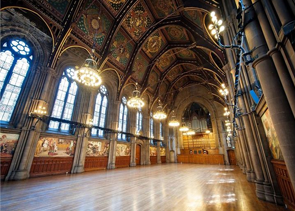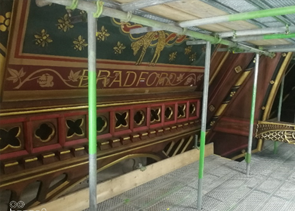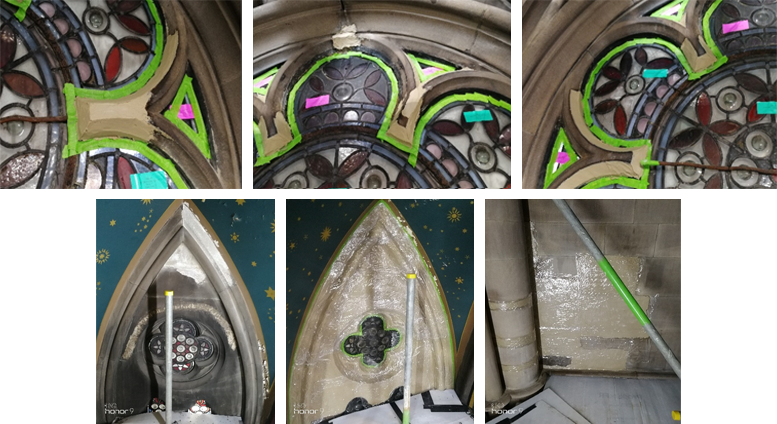Manchester Town Hall - cleaning and restoration of the Great Hall
Scope of works
- Cleaning of the stonework
- Lime mortar pointing
- Stone repairs / stone indents
- Descaling of the stonework
- Applying a Poultice to the stonework to remove salts.
James Stone Masonry Ltd in association with McCrory Holding are proud to have been involved in this prestigious project to restore the historic Grade One-listed Victorian Gothic edifice. The Great Hall in Manchester Town Hall is of immense importance: within the Great Hall there are 12 murals painted by Ford Madox Brown. These murals had to be protected and great care had to be taken when we were working around them.
The superb painted ceiling in this room is also quite remarkable, the ceiling is separated into panels bearing the coats of arms of principal countries and towns with which Manchester traded. The timber panels around the ceiling were cleaned taking great care not to damage the gold leaf and paint work to the woodwork.
 The Great Hall, Manchester Town Hall
The Great Hall, Manchester Town Hall Scaffolding erected for the restoration work
Scaffolding erected for the restoration work
80 tons of scaffold has been erected within the great hall to facilitate the restoration work of the painted ceiling panels, timber work stonework and stained-glass windows. The restoration of the painted ceils and stained-glass windows have been undertaken by others.
 Decoratively carved timber Truss cleaned with deionised water
Decoratively carved timber Truss cleaned with deionised water Timberwork cleaned using deionised water
Timberwork cleaned using deionised water
Latex cleaning of the stonework
The cleaning of the stonework was undertaken with great care all the stonework was first washed with deionised water. Then a latex cleaning compound was applied to the correct thickness and left to cure then peeled off the stonework achieving extraordinary results. Any sensitive and delicate areas were first of all protected before the latex was applied.

Removal of Salts in the stonework using a clay poultice
The pictures below show the process of the salt removal
- The stonework was first of all descaled
- The poultice is applied and covered with cling film to prevent the poultice drying out too quickly
- The poultice was removed, and the stonework was washed with deionised water
 Other areas where poultice was applied to remove salts from the stonework.
Other areas where poultice was applied to remove salts from the stonework.
 Lime mortar pointing to the stonework in the Great Hall
Lime mortar pointing to the stonework in the Great Hall
The old and defective joints were first of all cut out with a Fein cutter / mulit-tool and hand tools. Dampened wooden wedges were inserted into the joints to prevent any movement from other stones adjacent to the joint to be pointed. Tape was placed either side of the joint to prevent staining to the stonework adjacent. If the joint had to be back pointed damped hessian was inserted into the joint to prevent the mortar from drying out too quickly. The joint was then pointed to the required finish and tamped with a churn brush to pack the joint tight.
For further information visit www.jamesstonemasonryltd.co.uk













